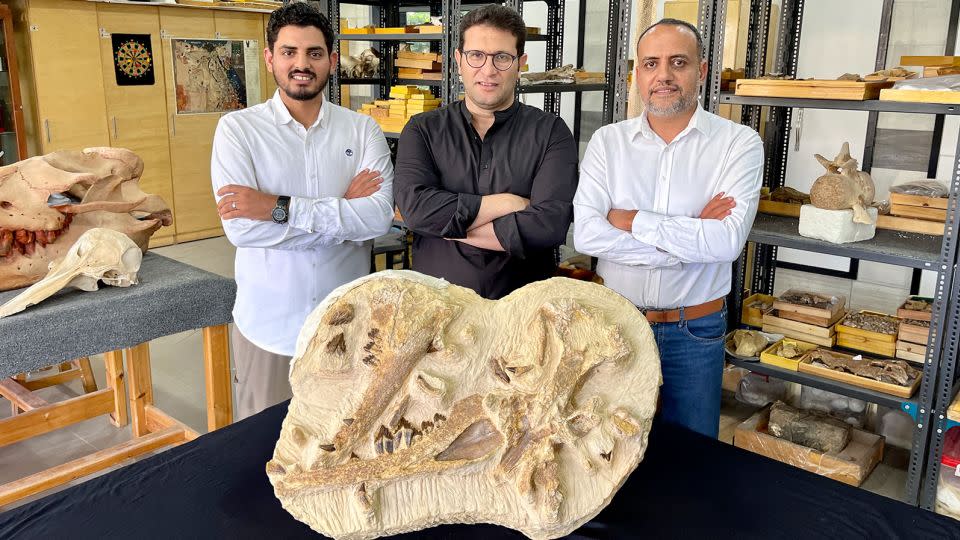Fossil discovery causes monumental shift in understanding of whale evolutionary history
- Oops!Something went wrong.Please try again later.
Editor’s note: Sign up for CNN’s Wonder Theory science newsletter. Explore the universe with news on fascinating discoveries, scientific advancements and more.
On the tail of the discovery of a whale fossil that is the largest animal on record, researchers in Egypt announced the unearthing of one of the smallest early whales known to science. The find is also the oldest fully aquatic whale found in Africa, according to a new study.
At an estimated body weight of 412.3 pounds (187 kilograms) and length of 8.2 feet (2.5 meters), the newly documented species is comparable in size to a modern-day bottlenose dolphin.
Tutcetus rayanensis is a member of the extinct family of early whales known as basilosauridae — the first widespread group to become fully aquatic. What’s more, the diminutive specimen is also much older than other basilosaurids of the Eocene Epoch, the study published Thursday in the journal Communications Biology revealed.
The Eocene Epoch lasted from about 55.8 million to 33.9 million years ago, and the fossil dates back about 41 million years. The remains include an incomplete skull with jaws; the hyoid apparatus, or bones that sit at the base of the tongue; and the topmost vertebra of a small subadult embedded in limestone.
The discovery of the whale fossil led to the establishment of a new genus within the basilosauridae family. Tutcetus is named for Pharaoh Tutankhamen, who died when he was 18, and the Greek word for whale, cetus.
“The discovery of the new basilosaurid whale, Tutcetus rayanensis, has brought about a substantial shift in our understanding of cetacean life histories during the Eocene epoch,” said lead study author Mohammed S. Antar, a paleontologist at the Mansoura University Vertebrate Paleontology Center in Egypt, via email.
Unlike earlier basilosaurid finds, there are indications that, despite its relatively small size, the subadult T. rayanensis and, quite possibly, other basilosaurids could have grown rapidly. They “might have undergone faster developmental processes than previously believed, suggesting a diverse range of growth strategies within this group,” Antar said.
The discovery “helps clarify parts of the evolutionary tree and pushes back some of the changes we thought were happening,” said paleobiologist Nicholas Pyenson, curator of fossil marine mammals at the Smithsonian National Museum of Natural History in Washington, DC. He wasn’t involved with the study.

Additionally, T. rayanensis differs from other basilosaurids in that the newly discovered whale did not replace its first premolar tooth. “This novel insight adds another dimension to our understanding of basilosaurid whales and their evolutionary adaptations in response to various ecological pressures,” Antar said.
Whales in the desert
The whale fossil was uncovered in the Wadi El-Rayan area, which sits about 24.9 miles (40 kilometers) northeast of the Wadi Al-Hitan World Heritage Site in Egypt’s Western Desert. The area is one of the world’s “most productive fossil whale sites,” according to the study.
As paleontologists continue working in the Wadi El-Rayan area, there’s a good chance they’ll find even earlier fully aquatic whales. “Our phylogenetic analysis suggests that the transition to a fully aquatic lifestyle likely occurred a few million years earlier than the age of Tutcetus, but we do not yet have any fossil evidence that conclusively documents these predicted earlier forms,” said study coauthor Erik R. Seiffert, professor and chair of the department of integrative anatomical sciences at University of Southern California’s Keck School of Medicine, via email. Seiffert helped assess Tutcetus after the fossil’s discovery.
An Egyptian team of researchers
The study also advances Egypt in the field of paleontology and science overall. “(T)his discovery marks a significant achievement for Egyptian and African paleontology. Tutcetus rayanensis is the second whale species, following Phiomicetus anubis, to be discovered, described, and named by Egyptian paleontologists,” Antar said via email.
This development is a major shift from paleontology practices of decades past. One paleontologist not affiliated with the study made sure to highlight this change. “I think the most important thing (is) really how special it is that we have Egyptian-led science coming out of Egypt on Egyptian fossils. That has historically not been the case,” said marine paleobiologist Carlos Mauricio Peredo, an assistant professor of biological sciences at Miami University in Oxford, Ohio.
Hesham Sallam, professor at the American University in Cairo and founder of the Mansoura University Vertebrate Paleontology Center, is the study’s project leader. The center, which opened in 2010, was the first of its kind in Egypt.
For more CNN news and newsletters create an account at CNN.com

